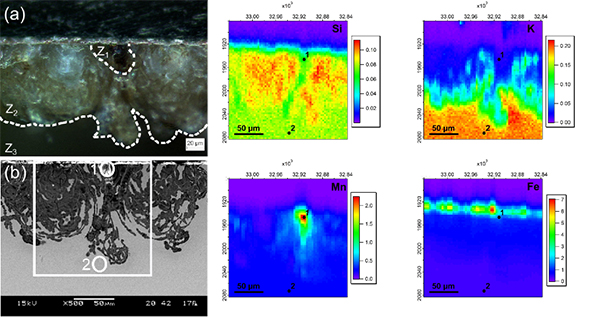Many stained glass windows have been altered by ages, although they are true medieval treasures. Among the frequently observed pathologies, the browning phenomenon reflects in the appearance of some brown spots at the surface which darkens the window and hampers the artwork legibility. At the present time, there is no efficient and lasting available treatment, so that in France curators recommend no to use any treatment at all. Scientists from the Laboratoire GéoMaterials et Environnements de l’Université Paris-Est Marne-la-Vallée, the Laboratoire de Recherche des monuments Historiques and the SOLEIL synchrotron have combined microscopic and spectroscopic techniques to investigate the chemical physical processes and better understand this degradation. Their results have been published in the Analytical Chemistry review.
During the fabrication process of sainted glass windows, manganese was used either as a dye to create violet or pink glasses, or as a bleach of the green shade due to the presence iron inside raw materials. Medieval stained glass windows, whose pieces contain manganese often suffer from pathology called “browning”. The phenomenon is reflected in the presence of Manganese-rich brown spots on or under the surface of the glass, thus limiting the passage of light and the artwork legibility. However it is a poorly documented pathology and its occurrence among sainted glass windows is not precisely known.
Researchers have analyzed free pieces of historical on site glass windows (from the 13th to the 16th century, France), and one archaeological sample from the 8th century in order to get a better understanding of this issue. Each sample was showing Manganese-rich brown spots at its surface or subsurface, and was analyzed with a combination of microscopic and spectroscopic techniques.
At first, optical microscopy and Scanning Electron Microscopy studies coupled with Energy Dispersive X-ray spectroscopy, allowed to map the brown areas on the samples, and to obtain quantitative chemical compositions of original glasses and of the altered zones. Inside a single sample, the size of altered spots varies. The archaeological sample is the one with the higher rate of altered areas.

The whole was then analyzed by X-ray absorption spectroscopy on the LUCIA beamline at SOLEIL, a technique with the one it’s possible to get information on the nature of brown phases, on the manganese oxidation state and its local environment. The photon beam was first lowered in order to limit photoreduction effects. Absorption spectra were compared with other ones collected from crystals containing manganese on several oxidized phases and variable environments.
Scientists actually demonstrated that the size the brown areas was correlated to the manganese oxidation state: manganese (II) in the little altered zones, manganese (III)in the archaeological sample, and a combination of both states. Previous studies suggested a localization of Mn in crystals of pyrolusite (a mineral of manganese dioxide). However absorption spectra of the present study are closer from the ones of purpurite, a mineral of manganese phosphate.
Using the high resolution of the synchrotron beam could be a key step to understand the variability of Mn- bearing phases in altered zones, and perhaps lead to an efficient and lasting treatment against the « browning » ?
